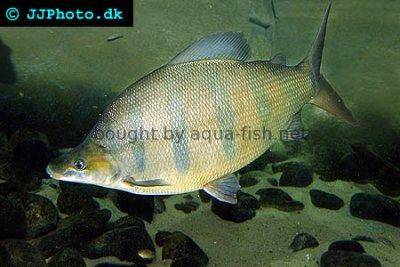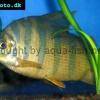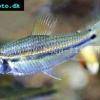Longsnout distichodus - Distichodus lusosso
Scientific name: Distichodus lusosso
Common name: Longsnout distichodus
Family: Distichodontidae
Usual size in fish tanks: 35 - 41 cm (13.78 - 16.14 inch)
014
Recommended pH range: 6.8 - 7.5
Recommended water hardness: 5 - 17°N (89.29 - 303.57ppm)
0°C 32°F30°C 86°F
Recommended temperature range: 22 - 27 °C (71.6 - 80.6°F)
The way how these fish reproduce: Spawning
Where the species comes from: Africa
Temperament to its own species: peaceful
Temperament toward other fish species: peaceful
Usual place in the tank: Middle levels
Food and Feeding
Longsnout Distichodus are omnivorous and thrive on a varied diet. Use a quality flake or sinking pellets as their staple food, supplemented with algae wafers to provide balanced nutrition. Offer occasional treats of live or frozen bloodworms and brine shrimp to keep them healthy and active. Since they are most active during the evening, feeding them at night ensures they receive their share of food.
Origin
Distichodus lusosso is native to Africa, specifically found in the River Congo basins spanning Angola and Cameroon. These regions are characterized by warm, slow-moving waters with sandy or gravelly substrates, which provide an ideal environment for these peaceful yet strikingly large fish.
Sexing
Determining the sex of Distichodus lusosso is easiest when viewed from above. Females are typically larger and exhibit a plumper body shape compared to the more streamlined males.
Breeding
As of now, there are no reported cases of Distichodus lusosso breeding successfully in home aquariums. Breeding this species in captivity would require careful preparation and ideal conditions. Large, frequent water changes with cooler water may potentially trigger spawning behavior. A shallow breeding tank with a gravel substrate and a ratio of one male to two females is suggested for best results. If spawning occurs, the eggs are typically scattered on the substrate or attached to surfaces. Parents should be removed after spawning to protect the eggs. The eggs, if viable, would likely hatch within 2-3 days, and the fry could be fed Infusoria or newly hatched brine shrimp once free swimming. However, achieving this in a home aquarium remains highly challenging and undocumented.
Lifespan
With proper care and optimal conditions, the average lifespan of Distichodus lusosso is 9-12 years. Providing a spacious tank, a balanced diet, and excellent water quality is essential to ensure they thrive and reach their maximum longevity.
Tank Setup and Behavior
Distichodus lusosso are large, peaceful fish that can grow up to 35 - 41 cm (13.78 - 16.14 inches), making them challenging to house in typical home aquariums. Due to their size and active swimming behavior, they require a tank with a minimum length of 180 cm (6 feet) and a capacity of at least 500 liters (132 gallons) to accommodate their needs. Their natural habitat includes soft, sandy, or gravel substrates with rocks and driftwood providing shelter and mimicking their native environments.
Because of their size and dietary preferences, these fish are best suited for spacious, specialized tanks rather than densely stocked community setups. If housed in community tanks, ensure they have peaceful tank mates of similar size and temperament. They do not compete well for food with smaller, faster species and may become stressed in overcrowded environments.
Suitable tank mates include:
- Silver Dollars – Peaceful schooling fish that match their size and activity levels.
- Severum Cichlids – Non-aggressive cichlids that coexist well.
- Clown Loaches – Bottom dwellers that thrive in larger tanks with peaceful tankmates.
Tank mates to avoid:
- Tiger Barbs – Their fin-nipping tendencies can stress or harm larger, slower fish.
- Oscar Cichlids – Their territorial nature may lead to aggression.
- Bettas – Incompatible due to their territorial behavior and size mismatch.
Given their size and dietary preferences, plants are often consumed or uprooted. However, hardy plants like Anubias or Java Fern, which can be attached to driftwood or rocks, may survive in their tank environment.
Short Description
Distichodus lusosso, commonly referred to as the Longsnout Distichodus, are large and peaceful fish native to the Congo River Basin in Africa. Despite their calm temperament, their significant adult size makes them more suitable for spacious, specialized aquariums rather than standard community tanks. They require a carefully maintained environment with ample swimming space, excellent water quality, and a diet primarily consisting of plant matter. With proper care and a suitable setup, these fish can display fascinating behaviors and make a captivating addition to large aquarium displays, especially for experienced aquarists prepared to meet their unique needs.
Pictures
Bought by aqua-fish.net from jjphoto.dk.



 Sixbar
Sixbar  Onebanded
Onebanded